|
|

This chapter provides physical and functional overviews of the Cisco AccessPath Integrated Access System. It contains:
Descriptions and examples of software commands are included only when they are necessary for replacing, installing, configuring, troubleshooting, or maintaining the AccessPath system hardware.
This chapter includes the following sections:
The Cisco AccessPath Integrated Access System is a scalable, high-density dial system designed to terminate a large number of mixed digital and analog calls. The AccessPath system provides dial access for service providers deploying large-scale (140 or more) hybrid access ports at a central site. It supports remote node or remote local area network (LAN) applications using either asynchronous modem or Integrated Services Digital Network (ISDN) technology and includes the latest access server, switching, and high-end routing features available with Cisco IOS software.
The AccessPath system integrates access servers, Ethernet switching, and high-end routers into a single Electronic Industries Association (EIA)-standard rack cabinet. It can terminate either analog modem or digital ISDN for all of the incoming lines. Processing tasks—such as answering and terminating calls—are divided among several CPUs, increasing overall system call processing and throughput performance.
The Cisco AccessPath Integrated Access System provides scalable dial-port counts and high-performance backbone routing in a distributed system architecture designed for the reliability and serviceability demanded by Point-of-Presence (POP) administrators who want to minimize downtime and service costs.
See Figure 1-1 for an illustration of a Cisco AccessPath Integrated Access System configured with 12 Access Server Shelves.
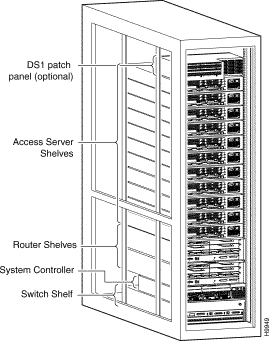
The Cisco AccessPath Integrated Access System supports the following features:
The AccessPath system allows dial Point-of-Presence (POP) managers to deploy large rotary groups in a short period of time. Cisco provides the AccessPath system preracked, precabled, and preconfigured with custom or sample (typical) configurations. This preconfiguration is intended to improve customer success during system setup and reduce installation and operation costs. Use of Cisco AccessPath Manager software is recommended to simplify network configuration.
The design of AccessPath system networks that are customized for a specific installation is the responsibility of the customer.
The AccessPath system supports Cisco IOS software. Deploying the AccessPath system provides not only a commitment to high quality access server technology but also to the design, operation, and maintenance of your entire POP network.
The AccessPath system offers guaranteed compatibility to networks that run Cisco IOS software. (Cisco IOS software runs on most of the world's internetworks, both on Cisco routers and on many partners' platforms.) The AccessPath system supports remote-node and remote-LAN dial protocols. Customers can leverage their current training and experience with Cisco IOS software to install, configure, and manage the AccessPath system.
When a customer purchases an AccessPath system of any size (from 6 to 24 PRIs), Cisco will install, wire, and configure the system for the most popular services available with Cisco IOS software. This lessens the cost of administering a POP because a great deal of the cost of any dial POP is in the physical design, integration, and testing of the equipment involved.
Cisco considers connect rates, throughput, reliability, and manageability as mandatory features of any properly designed dial POP. These are therefore provided as standard features of the AccessPath system. By providing alternate data paths from each access server to either one or two offload servers, full redundancy is provided for mission-critical data.
Each AccessPath system comes standard with a Failsafe/Console Management Shelf that is dedicated to providing console management of each device in the AccessPath system cabinet. This feature adds resiliency to every system by adding a single out-of-band console connection for every AccessPath system.
The AccessPath system supports a physical design in which each cabinet scales to a maximum hardware density of 24 PRIs. After this single cabinet limitation is reached, cabinets can be cascaded, connected by multiple Fast Ethernet (FE) connections effectively doubling or tripling the incoming rotary connections.
Software scalability is provided using Cisco IOS software and varies depending on the application. There are three orderable options representative of the most common applications for which the AccessPath system is utilized:
With access servers, an Ethernet switch, and high performance routers integrated into one cabinet, the AccessPath system avoids incompatibility concerns that normally plague multivendor or multibox installations. The AccessPath system is precabled and individual components are configured with custom or sample (typical) configurations, thereby guaranteeing interoperability.
The AccessPath system's modular cabinet architecture allows for the rapid implementation of new technologies and the swapping in of new hardware components as they become available.
T1 or E1 lines, supporting either ISDN Primary Rate Interface (PRI) or channel-associated signaling (CAS), feed into the AccessPath system's Access Server Shelves. Each Access Server Shelf has two lines. With a maximum configuration of 12 Access Server Shelves, the AccessPath system can accommodate up to 24 T1 or E1 connections. For information on the maximum number of calls that can be terminated in an AccessPath system depending on its configuration, refer to Table 1-1.
| Connection | Interface | Maximum Number of Calls (12 Access Server Shelves) | Call Type |
|---|---|---|---|
T1 | PRI | 552 | Analog or ISDN |
T1 | CAS | 576 | Analog |
E1 | PRI | 720 | Analog or ISDN |
E1 | CAS | 768 | Analog |
For example, an Access Server Shelf has two lines. In a T1 configuration, each of these lines can handle 23 calls (23B+D). The maximum configuration of 12 Access Server Shelves provides a maximum capacity of 552 ISDN PRI calls. The calls are aggregated in the Switch Shelf and multiplexed and sent over a 100BaseT Fast Ethernet connection to the Router Shelf.
Figure 1-2 illustrates call pathways through the AccessPath system.
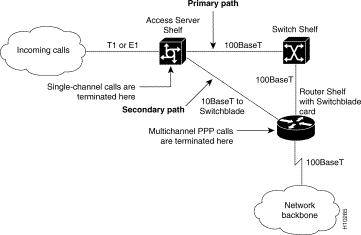
Figure 1-3 illustrates a typical single channel environment.
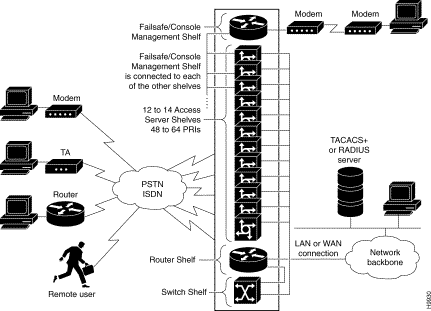
If a PPP session analog call comes in to an Access Server Shelf from the cloud, it is framed and forwarded (multiplexed) to the Switch Shelf, and then on to the Router Shelf.
Figure 1-4 illustrates a typical ISP environment using multichassis multilink PPP (MMP).
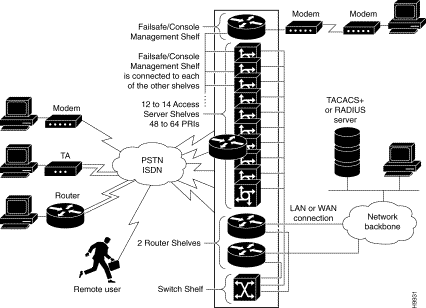
From the Router Shelf, customers can route calls to a wide variety of services. Calls can be routed to a WAN, or to another switch. If calls are forwarded through a WAN to a Home Gateway, they are not answered in the Router Shelf, but by the Home Gateway.
The Cisco AccessPath Integrated Access System includes the following components:
This section describes the physical characteristics of these components in their relationship with one another as part of the Cisco AccessPath Integrated Access System. For more information about each of these components, refer to the documents listed in the table "Related and Referenced Documents" in the chapter "About This Guide."
Table 1-2 details the physical specifications for the AccessPath system.
| Description | Specification |
|---|---|
|
80.25 x 23.25 x 38 in. (203.8 x 59.1 x 96.5 cm) 80.25 x 23.25 x 36 in. (203.8 x 59.1 x 91.4 cm) |
Minimum: 250 lb (113.6 kg) | |
Input voltage, DC power supply | -48 VDC nominal |
Operating environment | 32 to 104ºF (0 to 40ºC) |
Nonoperating temperature | -4 to 149ºF (-20 to 65ºC) |
Operating humidity | 10 to 85%, noncondensing |
Regulatory Compliance and Safety | See the document Regulatory Compliance and Safety Information for the Cisco AccessPath Integrated Access System |
The AccessPath system has a single EIA standard 19-in. (48.3 cm) rack cabinet 78 in. (198.1 cm) high that accommodates up to 576 simultaneous callers terminated in a single T1-configured cabinet (up to 768 in an E1-configured cabinet).
The types of interfaces are as follows:
The AccessPath system also supports CT3, NxT1, and NxCT1 for dedicated connections.
Additional specifications for the individual shelves that make up the Cisco AccessPath Integrated Access System are detailed in the sections that follow.
The AccessPath system comes in two standard configurations: one designed for single channel interfaces and one designed for multilink interfaces. Both configurations include:
The single channel interface configuration of the AccessPath system is designed for POPs that primarily service single channel dial up connections. It consists of the following items:
For an example of a single channel interface configuration of the AccessPath system, see Figure 1-3.
The multilink interface configuration of the AccessPath system is designed for Points-of-Presence (POPs) that primarily service multilink connections. Removing two Access Server Shelves allows for the inclusion of a second Router Shelf. This configuration consists of the following items:
For an example of a multilink interface configuration of the AccessPath system, refer to Figure 1-4.
To provide out-of-band management services, the AccessPath system uses a Failsafe/Console Management Shelf. For an illustration of the Failsafe/Console Management Shelf, see Figure 1-5.
The Failsafe/Console Management Shelf has the following hardware features:
The serial WAN connections use a proprietary, 60-pin connector. The Ethernet and Token Ring connections use standard LAN cabling with an attachment unit interface (AUI) or DB-9 connector. The console terminal is used to provide basic and emergency local system access. The auxiliary port is used to provide basic and emergency remote system access.
The access server uses a 68-pin connector and breakout cable, which provides 8 RJ-45 ports on each cable. These ports use RJ-45-to-DB-25 adapters to connect to asynchronous devices.

Specifications of the Failsafe/Console Management Shelf are listed in Table 1-3. For more information on agency compliance, refer to the document Regulatory Compliance and Safety Information for the Cisco AccessPath Integrated Access System.
| Description | Specification |
|---|---|
Dimensions (H x W x D) | 1.75 x 17.5 x 10.56 in. |
10 lb (4.5 kg) | |
Input voltage, AC power supply | 100 to 240 VAC |
40W, 40 to 72 VDC | |
20-MHz Motorola 68EC030 | |
Network interface options | 1 Ethernet, 2 synchronous serial, 16 asynchronous serial |
Ethernet interface | Ethernet AUI IEEE 802.3 |
Token Ring interface | IEEE 802.5 (DB-9) |
Synchronous serial interfaces | EIA/TIA-232, EIA/TIA-449, V.35, X.21 (NRZ/NRZI2 and DTE/DCE3 mode) |
Asynchronous serial interfaces | EIA/TIA-232 Asynchronous serial interfaces use RJ-45 connectors |
Console and auxiliary ports | Asynchronous serial (RJ-45) |
Operating environment | 32 to 104ºF (0 to 40ºC) |
-40 to 185ºF (-40 to 85ºC) | |
5 to 95%, noncondensing | |
34 dBa @ 3 ft (0.914 m) |
| 1BTUs = British thermal units. 2NRZ = nonreturn to zero; NRZI = nonreturn to zero inverted. 3DTE = data terminal equipment; DCE = data communications equipment. |
The access server provides the greatest benefit for midsized organizations that need to centralize processing capabilities for mobile users and telecommuters.
The access server is optimized for high-speed modem access and is ideally suited for all traditional dialup applications, such as access to a host, electronic mail, file transfer, and dialin access to a LAN.
The Access Server Shelf accommodates up to three feature cards—one WAN card and one or two modem carrier cards. The choice of cards is as follows:
The Access Server Shelf also includes these ports:
The Access Server Shelf can be managed with software ranging from a simple terminal command line interface for device configuration to a simple network management protocol (SNMP) network manager. For more information about managing the access server using a network manager, refer to the Installing Cisco AccessPath Manager publication and the online help that is part of that software package.
Each Access Server Shelf consists of the following components:
Figure 1-6 shows the interfaces on the rear panel of an Access Server Shelf.

The Access Server Shelf can contain 12 to 48 modem ports installed on two carrier cards in the chassis card slots. Each modem carrier card can hold two 12-port modem cards.
The modem cards connect through the carrier card and the system backplane to the dual T1 PRI. Transmission or reception is then accomplished on T1 lines connected to the dual T1 PRI card.
Each modem supports V.42bis data compression and uses the Hayes Smartmodem AT and V.25bis command sets. The Microcom Networking Protocol (MNP) and V.42 error-correction protocol standards provide error-free performance. The modem offers MNP Class 10 with Adverse Channel Enhancements (ACEs). MNP 10 includes:
Each modem supports the following protocol and modulation standards:
The dual T1 PRI card routes incoming digital T1 lines to the modem cards. The dual T1 PRI card provides RJ-48C connector(s) to terminate the trunk(s). The dual T1 PRI card performs all necessary equalization and gain functions to support 6000 feet of 24-gauge unshielded cable. This card complies with all Bellcore standards relating to T1 (ANSI T1.403) alarms, loopbacks, and error detection. The dual T1 PRI card is equipped with an integrated CSU.
The dual T1 PRI card handles up to 48 digital signal level 0 (DS-0) channels from two trunks. Each channel carries either a pulse code modulation (PCM)-encoded voice channel or digital data. The dual T1 PRI card supports 64-kbps clear channel operation for data or voice channels and feature group B operation for voice channels.
The Dual E1 PRI card is installed in the access server to provide physical termination for two E1 PRI lines. The card is designed to support the E1 cable standard of 30 Bearer (B) channels for voice and data, one Data (D) channel for signaling, and one channel for framing. Each channel transmits at up to 64 kbps for a combined total of 2.048 Mbps for each E1 PRI line.
The specifications of the Access Server Shelf are listed in Table 1-1. For more information on agency compliance, refer to the document Regulatory Compliance and Safety Information for the Cisco AccessPath Integrated Access System.
| Description | Specification |
|---|---|
Dimensions (H x W x D) | 3.5 x 17.5 x 15 in. (8.89 x 44.45 x 38.1 cm) |
25 lb (11.4 kg) | |
Input voltage, AC power supply | 100 to 240 VAC1 |
Input voltage, DC power supply | -48 to -60 VDC3 |
20-MHz Motorola 68EC030 | |
Dual T1 PRI (RJ-48C) Dual E1 PRI (DB-15) Five-in-one synchronous serial (DB-60) | |
Ethernet AUI4 (DB-15) | |
Synchronous serial interfaces (five-in-one synchronous serial WAN ports) | EIA/TIA5-232, EIA/TIA-449, V.35, X.21 (NRZ/NRZI6 and DTE/DCE7 mode) |
Asynchronous serial (RJ-45) | |
Alarm relay rating: | |
32 to 104ºF (0 to 40ºC) | |
-40 to 185ºF (-40 to 85ºC) | |
5 to 95%, noncondensing | |
34 dB9 @ 3 ft (0.914 m) |
The Router Shelf The router shelf provides process server and backhaul router functionality. It is configured in the following way:
The six-slot Router Shelf supports multiprotocol, multimedia routing and bridging with a wide variety of protocols and any combination of Ethernet, Fast Ethernet, and serial media.
Network interfaces reside on port adapters that provide the connection between the router's three Peripheral Component Interconnect (PCI) buses and external networks. The Router Shelf has six slots (slot 1 through slot 6) for the port adapters, one slot for an Input/Output (I/O) controller, and one slot for a network processing engine.
For the standard port adapter configurations for AccessPath system Router Shelves, see Table 1-5.
| Configuration | Shelf | Port Adapter Slot Configuration |
|---|---|---|
Single Router Shelf | Router Shelf 1 | Slot 1—Fast Ethernet Slot 2—4-port serial Slot 3—4-port serial Slot 4—4-port serial Slot 5—4-port serial Slot 6—Backhaul (customer-configurable) |
Dual Router Shelf | Router Shelf 1 | Slot 1—Fast Ethernet Slot 2—4-port serial Slot 3—4-port serial Slot 4—Blank Slot 5—Blank Slot 6—Backhaul (customer-configurable) |
Dual Router Shelf | Router Shelf 2 | Slot 1—Fast Ethernet Slot 2—4-port serial Slot 3—4-port serial Slot 4—Blank Slot 5—Blank Slot 6—Backhaul (customer-configurable) |
There are bays for up to two AC-input or DC-input power supplies. The Router Shelf will operate with one power supply. A second power supply, which is not required, is shipped with the AccessPath system to allow load sharing and increased system availability. The Router Shelf does not support a mixture of AC- and DC-input power.
The Router Shelf provides the following features:
The front of the Router Shelf provides access to an I/O controller and up to six network interface port adapters (see Figure 1-7). The I/O controller contains the following: a local console port for connecting a data terminal (or data terminal equipment [DTE]) and an auxiliary port for connecting a modem (or other data communications equipment [DCE]) or other devices for configuring and managing the router; two Personal Computer Memory Card International Association (PCMCIA) slots for Flash memory cards; an optional Fast Ethernet port. The Fast Ethernet port provides a 100-Mbps connection to the network.

The port adapters installed in the Router Shelf support OIR.
Port adapter slots in the Router Shelf are numbered from left to right, beginning with port adapter slot 1 and continuing through port adapter slot 6. Port adapter slot 0 is the Fast Ethernet port on the I/O controller (refer to Figure 1-8).

The rear of the Router Shelf provides access to the network processing engine and up to two power supplies (refer to Figure 1-9).

The 150-MHz network processing engine has no external connectors or LEDs. There are two handles for removing and installing the network processing engine and two captive installation screws for securing it to the chassis.
Table 1-6 lists the Router Shelf physical specifications and power requirements. For more information on agency compliance, refer to the document Regulatory Compliance and Safety Information for the Cisco AccessPath Integrated Access System.
| Description | Specification |
|---|---|
Midplane | Two primary PCI buses and one secondary PCI bus with an aggregate bandwidth of 600 Mbps1 |
Dimensions (H x W x D) | 5.25 x 16.8 x 17 in. (13.34 x 42.67 x 43.18 cm) |
Weight | Chassis fully configured with a network processing engine, I/O controller, 6 port adapters, 2 power supplies, and a fan tray: ~ 50 lb (22.7 kg) |
Heat dissipation | 370W (1262 Btus2) |
AC-input power | 370W maximum (with either a single or dual power supply configuration) |
AC-input voltage | 100 to 240 VAC3 wide input with power factor correction |
AC-input current rating | 5A4 maximum at 110 VAC and 2.5A maximum at 240 VAC with the chassis fully configured |
AC-input cable | 18 AWG5 three-wire cable, with a three-lead IEC-320 receptacle on the power supply end, and a country-dependent plug on the power source end |
DC-output power | 280W6 maximum (with either a single or dual power supply configuration) |
DC-input power | 370W maximum (with either a single or dual power supply configuration) |
DC-input voltage | -48 VDC7 nominal in North America -60 VDC nominal in the European Community |
DC-input current rating | 14A maximum at -48 VDC |
DC-input cable | 14 AWG recommended minimum, with at least three conductors rated for at least 140ºF (60ºC) |
Frequency | 50/60 Hz8 |
Airflow | ~80 cfm9 |
Temperature | 32 to 104ºF (0 to 40ºC) operating; -4 to 149ºF (-20 to 65ºC) nonoperating |
Humidity | 10 to 90% noncondensing |
Software requirement | Refer to the document Release Notes for the Cisco AccessPath Integrated Access System |
Agency approvals | Safety: UL 1950, CSA 22.2 No. 950, EN60950, AUSTEL TS001, |
The Switch Shelf is configured in the following way:
The Switch Shelf provides high-density switched Ethernet and Fast Ethernet using unshielded twisted-pair (UTP) and multimode fiber cable.
The Switch Shelf supports switched 10-megabit-per-second (Mbps) Ethernet, Ethernet repeater connections, and stored and switched 100-Mbps Fast Ethernet with backbone connections to Fast Ethernet and Copper Distributed Data Interface (CDDI). Typically, Switch Shelf Ethernet interfaces connect workstations and repeaters; the Fast Ethernet interfaces connect to workstations, servers, switches, and routers.
The AccessPath system Switch Shelf chassis has five slots. The first slot is for the supervisor engine module, which provides switching, local and remote management, and dual Fast Ethernet interfaces. The remaining slots are available for any combination of Ethernet and Fast Ethernet modules. All interfaces are accommodated in a 19-inch rack. The switch supports single or redundant AC- or DC-input power supplies.
The Switch Shelf includes a single, integrated 1.2 gigabit-per-second (Gbps) frame-based switching backplane. The media-independent backplane provides wire-speed connections for all ports. The architecture supports the following interface and network technologies:
The backplane is the backbone module; it provides the connection between the supervisor engine module, interface modules, and power supplies. (See Figure 1-10.) Inside the chassis, the backplane slots are numbered 1 through 5, with 1 at the top of the card cage and 5 at the bottom. The Switch Shelf backplane has no active components that could fail; it is completely passive.
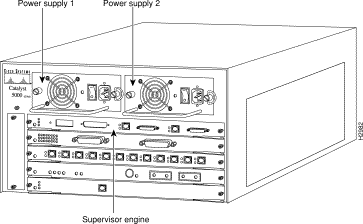
The Switch Shelf provides the following features:
The Switch Shelf consists of the following components.
The AccessPath system Switch Shelf has a 1.2-Gbps media-independent switch fabric. The backplane provides the connection between power supplies, supervisor engine modules, interface modules, and the backbone module. The 1.2-Gbps media-independent fabric supports Ethernet, Fast Ethernet, and Copper Distributed Data Interface (CDDI) modules.
The AccessPath system Switch Shelf supervisor engine module has the following features:
For software feature descriptions, refer to the Cisco AccessPath Integrated Access System Software Configuration Guide.
This section describes the functions supported in the Switch Shelf, including:
| Description | Specification |
|---|---|
Dimensions (H x W x D) | 10.4 x 17.21 x 18.14 in. (26.2 x 42.5 x 44.5 cm) |
Weight | 43 lb (19.5 kg) minimum |
AC-input power | 370W1 maximum (with either a single or dual power supply configuration) |
AC-input voltage | 100 to 240 VAC2 wide input with power factor correction |
AC-input current rating | 2.5A3 maximum at 90 to 132 VAC |
AC-power dissipation | 350W maximum configuration |
DC-input voltage | +5VDC4 @ 70A +12VDC @ 2A +24VDC @ 0.12A |
DC-input power | 370W maximum (with either a single or dual power supply configuration) |
DC-input voltage | -40.5 VDC to -72 VDC continuous
|
DC-input current rating | 14.0A max @ 48 VDC (nominal) 11.0A max @ 60 VDC (nominal) |
DC-input cable | 14 AWG5 recommended minimum, with at least three conductors rated for at least 140ºF (60ºC) |
Processor | 25 MHz Motorola 68EC040 |
LAN interfaces | 10BaseT Ethernet |
| 1W = Watts 2VAC = volts alternating current 3A = ampere 4VDC = volts direct current 5AWG = American Wire Gauge |
![]()
![]()
![]()
![]()
![]()
![]()
![]()
![]()
Posted: Mon Oct 2 13:11:21 PDT 2000
Copyright 1989-2000©Cisco Systems Inc.